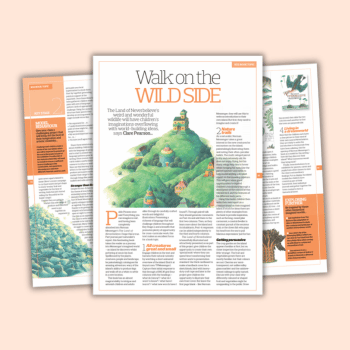The Land of Neverbelieve’s weird and wonderful wildlife will have children’s imaginations overflowing with world-building ideas. This text makes an excellent focus for a book topic.
Work on presentation skills by creating your own book, go on a nature trail and see how a story is present even in a non-fiction format.
Pablo Picasso once said ‘Everything you can imagine is real’. Having been completely absorbed into Norman Messenger’s The Land of Neverbelieve, I hope this is true.
Part journal, part naturalist’s report, this fascinating book takes the reader on a journey into Messenger’s imagined world. He discovers an island whilst pottering at sea in his boat.
Spellbound by the plants, creatures, people and landscape, he painstakingly catalogues his amazing adventure, wary of the island’s ability to produce legs and walk off on a whim to settle in a new location.
This book has an almost magical ability to intrigue and astonish children and adults alike through its carefully crafted words and delightful illustrations.
The book possesses a richness of language that will challenge children throughout Key Stage 2. It has a breadth that promotes plenty of opportunity for cross-curricular work.
Clare Pearson is deputy headteacher at Summerbank Primary School in Stoke. Previously, Clare was the Primary Advisory English Teacher for Stoke-on-Trent.











